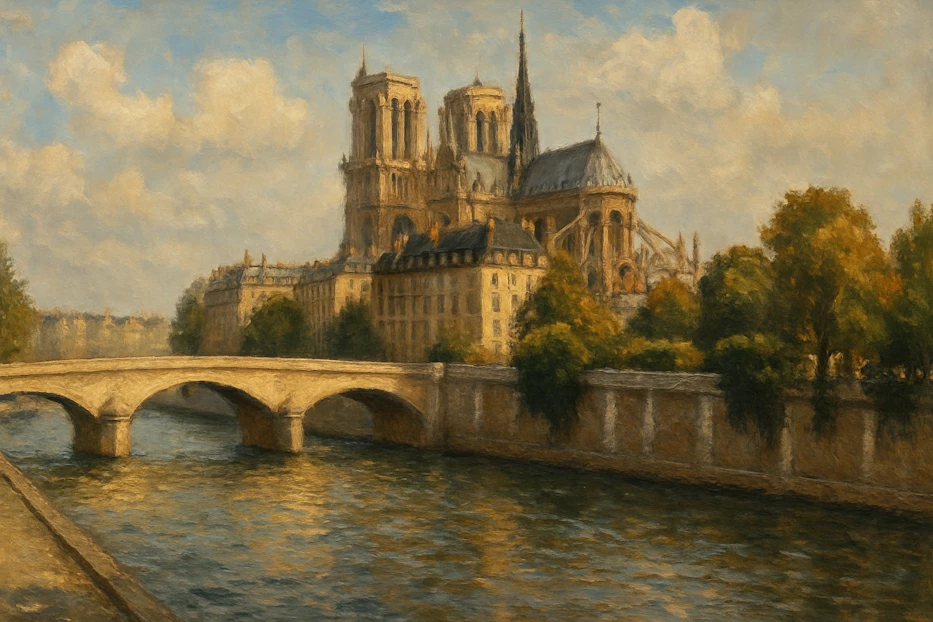Paris has long been known for its romantic ambiance, world-famous landmarks, and rich cultural history.
Among its many charms are the islands nestled in the Seine River, each with its own unique character and story. In fact, the Seine River in Paris is home to three islands. These islands are not only integral to the city’s history and charm but also offer a unique perspective on the Parisian experience.
Table of Contents
Île de la Cité: The Birthplace of Paris
At the heart of Paris lies Île de la Cité (City Island), one of the two remaining natural islands on the Seine. It is here that Paris began its journey as a city. This island is considered the historic birthplace of Paris, once known as Lutetia during the Roman era.
Back then, the island was a strategic location due to its defensive capabilities, allowing the early settlers to fend off invaders. Over the centuries, it developed into the medieval heart of Paris, rich with architecture, history, and cultural significance.
Today, Île de la Cité is home to several of Paris’s most iconic landmarks, particularly Notre-Dame Cathedral, which dominates the island’s skyline.
Until the devastating fire in the spring of 2019, the majestic cathedral, with its Gothic architecture and centuries-old history, had drawn millions of visitors each year. Its central location on the island makes it a focal point for exploring the area.
The island also houses Sainte-Chapelle, a stunning royal chapel known for its breathtaking stained glass windows, and the Conciergerie, a former royal palace turned prison during the French Revolution.
In terms of size, Île de la Cité is relatively small. It covers just around 22.5 hectares (about 56 acres), yet it holds a disproportionately significant place in the history of Paris. Despite its diminutive size, the island has played a crucial role in shaping the city’s identity and remains a must-visit destination for anyone interested in the roots of Paris.
Île Saint-Louis: A Peaceful Oasis
Just a stone’s throw from Île de la Cité lies Paris’s second natural island, Île Saint-Louis (St. Louis Island). Compared to its more famous neighbor, Île Saint-Louis has a quieter, more residential feel, providing a peaceful respite from the bustling streets of the city.
While Île de la Cité is a hub for tourists, with historical landmarks and throngs of visitors, Île Saint-Louis feels more like a hidden gem. The island was named after King Louis IX, commonly known as Saint Louis, and it was developed during the 17th century.
It is primarily residential and is known for its elegant townhouses, narrow cobblestone streets, and charming cafés. It’s a place to take a leisurely stroll, savor an ice cream from the famous Berthillon shop, or simply admire the serene beauty of the Seine as it flows on either side.
Île Saint-Louis is often viewed as one of Paris’s most exclusive neighborhoods, offering a more tranquil experience compared to other parts of the city. Though it lacks the grand historical landmarks of Île de la Cité, it more than makes up for it with its atmosphere of understated elegance and refinement.
Together, Île de la Cité and Île Saint-Louis form the two remaining natural islands in France‘s capital. These islands, though small in size, hold immense cultural and historical significance and remain central to the Parisian experience.
Direct Ferries
Routes, Schedules, Prices
Ferries to France
Île aux Cygnes: Paris’s Man-Made Island
In addition to the two natural islands, Paris is also home to one man-made island within the Seine: Île aux Cygnes (Island of Swans). Created in 1827, Île aux Cygnes is a long, narrow artificial island that stretches between the Pont de Bir-Hakeim and the Pont de Grenelle.
Though not home to actual swans, Île aux Cygnes is famous for the Statue of Liberty replica located at its western end. This smaller version of the New York statue faces westward in a symbolic gesture of friendship between France and the United States.
The island’s main feature is its picturesque promenade, Allée des Cygnes, which runs along its length, offering a peaceful walking path with scenic views of the Seine and the surrounding city.
Former Islands in the Seine
In the past, there were several smaller islands in the Seine River that have since disappeared or been absorbed into the city’s landscape through urban development. Île Louviers, for example, was once a small island near the Pont Marie but was filled in during the 19th century. While it no longer exists today, its history reflects the evolving geography of Paris and the river that has shaped the city.
Paris by the Seine: A Unique Perspective
One of the best ways to take in the beauty of Paris’s islands and iconic landmarks is by embarking on a Seine River cruise. These cruises offer a unique vantage point, allowing passengers to glide past some of Paris’s most famous sites, such as Notre Dame Cathedral, the Eiffel Tower, and the Louvre.
Whether opting for a romantic dinner cruise, a daytime sightseeing trip, or a private boat tour, there’s a variety of options to suit every traveler. As the boat gently drifts along the river, stunning views of the city’s architecture and its islands unfold, providing a memorable way to explore Paris.

